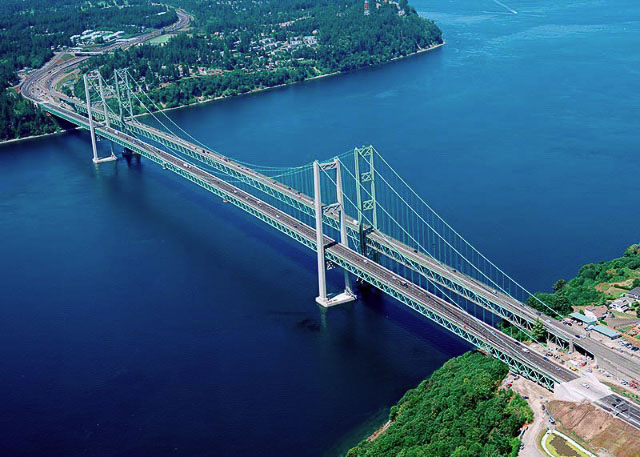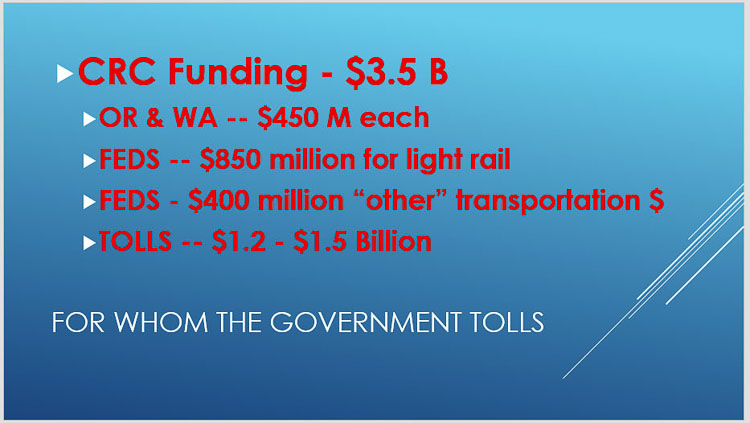Will legislators discuss toll reduction or elimination for Clark County and Southwest Washington?
When it comes to statewide transportation projects in Washington, tolling has been used at times to pay for borrowed money. That is what happened when the first span of the Interstate Bridge was initially constructed in 1917, and then briefly when the second span was built in 1958. The first span also received a significant upgrade at that time. The tolls lasted for 11 years on the original structure and six years on the second structure.
A very similar process happened when the Tacoma Narrows Bridge was built. When the second 5,797 foot bridge was constructed in 2007, the state borrowed $691 million of the $786 million price tag. Tolls are used to pay back the lenders, but local citizens are currently crying foul over the cost of increasing toll rates.
A lot of people on the Kitsap Peninsula got really excited in December when Democratic state Sen. Emily Randall (Democrat, 26th District) pre-filed a bill that would have eliminated the tolls on the Tacoma Narrows Bridge. Her bill would have transferred $772 million from the general fund to pay off all the debt and deferred sales tax for construction. That would have eliminated the tolls this year, not unlike receiving an unexpected inheritance and paying off your home mortgage.
Randall’s bill did not pass, but a form of the bill is still alive. Substitute Senate Bill 5488 has passed the Senate floor and is now in the House for debate. It would transfer $130 million from the general fund over the next 10 years, and reduce the current toll rate by $0.75 and keep it at $4.50 for Good to Go pass holders.

In the failed Columbia River Crossing (CRC), tolling was a significant part of the financial plan to pay for an estimated $1.2 billion to $1.4 billion in borrowed funds. The total project was estimated to cost $3.5 billion.
Forensic accountant Tiffany Couch of Clark County scrutinized all the financial data of the CRC. The Acuity Forensics analysis revealed that $3.3 billion would be needed in toll revenue to pay off the $1.2 billion in borrowed money.
“We can confirm that the estimated price of debt service, toll collection and bridge operation and maintenance will be $2.0 billion over a 30 year span; bringing the total cost of the CRC project to $5.5 billion,” Couch wrote in her Report #4 Columbia River Crossing – Funding Plan Analysis. It was sent to Congresswoman Jaime Herrera Beutler and also officials in both state legislatures.
“It is also our opinion that the CRC project office has misled the public by indicating that just $1.2 billion in tolls will be collected as payment for this project. The CRC project office’s own documents clearly indicate that the $1.2 billion in toll collection represents only capital related costs. According to the CRC’s finance plans, an additional $2.0 billion in tolls will need to be collected for the aforementioned debt service and bridge operation and maintenance costs. In fact, the CRC debt service schedules estimate that a total of $3.3 billion, not 1.2 billion, in tolls will be collected over a 30 year period.”
Additionally, Couch reported tolling rates will range between $5 and $16 round trip. She also stated “current Washington State projects call into question WSDOT’s ability to keep tolling rate promises and to manage debt payments.”
Keeping promises to constituents becomes a concern after the debt has been incurred. The state legislature had to bail out tolling facilities last year with money from the general fund, Pandemic related toll revenues fell precipitously statewide, decreasing 30 percent to $46.6 million over the prior year.

The cost to collect tolls has been as high as 43 percent of revenues on Seattle’s I-405, prior to needing to be bailed out by the legislature during the pandemic.
Senator Randall told the House Transportation Committee on Monday she’s fighting to help her constituents. “That’s real money. It puts money back in the pockets of working people,” Randall said. “That’s about $195 for a single person that drives back and forth every weekday for a year.” Presently her constituents are paying $1,300 a year in tolls.
Now is a good time to work on this she says, with the state revenue forecasts showing more money is available. “At a time when we have such a strong budget outlook and unspent federal money for COVID recovery, the Legislature should seize the opportunity to significantly reduce the tolls,” she said.
There is a similar proposal in the House, which received its first hearing Monday. It would take $85 million from the general fund and apply it to the debt. That would reduce the current toll by $0.25. This was originally proposed as a loan in the 2018 legislative session, but it would become a grant under this plan, with no expectation it would be repaid.
Against this backdrop is the plan to replace the I-5 Interstate Bridge across the Columbia River. The Interstate Bridge Replacement (IBR) program team tells citizens the as yet undefined plan will require tolling, even though there is no specific project, nor a specific cost.
But when Washington Gov. Jay Inslee and Oregon Gov. Kate Brown signed their Memorandum of Intent that resurrected the project, their agreement said the project would include tolls. “When reevaluating the finance plan for the project, the project office shall assume that some costs of the new facility may be covered by tolls.”
But a specific dollar amount needing to be borrowed, and how much the tolls would be have not been revealed. A tolling study and analysis will be conducted by Greg Johnson and his IBR team later this year, after a solution has been proposed.
The financial reality is that Oregon and Washington are expecting to receive at least $14 billion from the federal government, via the $1.2 trillion Infrastructure Investment and Jobs Act (IIJA).
According to Oregon Sen. Ron Wyden, Oregon alone will receive $5.36 billion. Washington is expected to get $8.6 billion. Wyden touts the possibility of “more” being available via competitive “grants.” This money is added to the $6.6 billion (biennium) Washington will spend on transportation and Oregon will spend $3.3 billion in highway fund revenue for 2022-23.

“The total will be higher than that, once the new programs are established and funding from competitive grants is factored in,” Wyden said. “The competitive awards for projects in Oregon will vary from year to year, so there is no way to know yet exactly how much Oregon will receive over the five-year span.”
IBR’s Greg Johnson shared the following with Clark County Today, prior to the final passage of the IIJA package last fall.
“Tolling is a part of that solution, because neither one of the states can afford to take this bigger chunk out of their program and still get the other things they need to get done,” he said. “This would cripple their programs for years to come, if they had to pay for it solely out of revenue that comes to them from either state or federal sources. Tolling is a best practice.”
The Washington legislature presently has over $10 billion in additional revenue in their budget projections. Last year, Oregon had a $1.9 billion surplus, triggering their “kicker” rebate to taxpayers.
With both Oregon and Washington awash in taxpayer revenue, why is there a need to borrow any money to fund the Interstate Bridge? Paying cash would eliminate the need for tolling, which Vancouver Councilor Bart Hansen has appropriately said would create “roads for the rich.”




